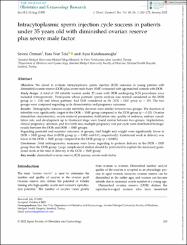Intracytoplasmic sperm injection cycle success in patients under 35 years old with diminished ovarian reserve plus severe male factor
Künye
Özmen, S., Tola, E. N. ve Karahasanoğlu, A. (2023). Intracytoplasmic sperm injection cycle success in patients under 35 years old with diminished ovarian reserve plus severe male factor. Journal of Obstetrics and Gynaecology Research, 49(1), 265-272. https://doi.org/10.1111/jog.15470Özet
Objective We aimed to evaluate intracytoplasmic sperm injection (ICSI) outcomes in young patients with diminished ovarian reserve (DOR) plus severe male factor (SMF) compared with age-matched controls with DOR. Study design A total of 189 infertile women under 35 years with DOR undergoing ICSI procedures were included retrospectively. Participants whose partners' sperm analysis was normal considered as the DOR group (n = 154) and whose partners' had SMF considered as the DOR + SMF group (n = 35). The two groups were compared regarding cycle characteristics and pregnancy outcomes. Results Demographic features except infertility duration were similar between two groups. The duration of infertility was significantly longer in the DOR + SMF group compared to the DOR group (p = 0.02). Ovarian stimulation characteristics, oocyte retrieval parameters, fertilization rate, quality of embryos, embryo cancellation rate, and development up to blastocyst stage were found similar between two groups. Implantation, clinical pregnancy, abortion, and live birth rate, multiple pregnancy rate per cycle were distributed homogenously between the DOR and DOR + SMF groups. Regarding perinatal and neonatal outcomes of groups, fetal height and weight were significantly lower in DOR + SMF group than in DOR group (p = 0.001 and 0.01, respectively). Gestational week at delivery was lower in the DOR + SMF group compared to the DOR group (p < 0.0001). Conclusion Fetal anthropometric measures were lower regarding to preterm delivery in the DOR + SMF group than the DOR group. Large sample-sized studies should be performed to explain the decreased gestational week at the time of delivery in the DOR + SMF group.
WoS Q Kategorisi
Q4Scopus Q Kategorisi
Q2Kaynak
Journal of Obstetrics and Gynaecology ResearchCilt
49Sayı
1Koleksiyonlar
- Makale Koleksiyonu [3777]
- PubMed İndeksli Yayınlar Koleksiyonu [4230]
- Scopus İndeksli Yayınlar Koleksiyonu [6574]
- WoS İndeksli Yayınlar Koleksiyonu [6631]


















